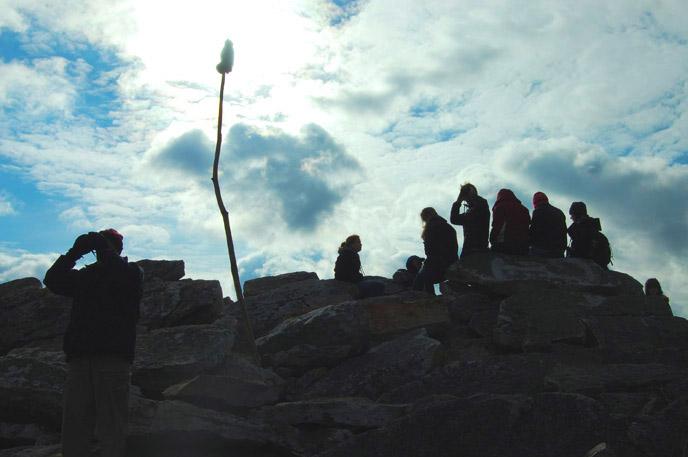Dickinson College
Raptor Shadows on the Sleeping Blue Lady

The Natural History Sustainability Mosaic climbs Waggoners Gap for hawk watching
Photo and text by Tony Moore
On the jagged outcropping of Tuscarora sandstone and quartzite that defines Waggoners Gap, just north of Carlisle, the wind feels like it must be blue, it's blowing so cold and hard. The sky continually transforms from overcast to blinding, unsheltered glare. Either way, the day doesn't want to warm up.
It's perfect weather for a hawk watch, though, and according to the Audubon Society, "there is no better place in Pennsylvania" than right here for Visiting Instructor in Biology Gene Wingert and his Mosaic students to set up and watch the sky. What they're looking for are raptors—birds of prey such as eagles, falcons, buzzards and hawks—and they're not alone up here.
"The hawk watch is what we call community science," Wingert says, indicating the collection of everyday bird-watchers scattered across the rocks, all aiming cameras and binoculars at the sky. "Most of the people doing the hawk watching are not scientists—they just have this interest in birds."
Hawks and the people who watch them
Ensconced in camouflage, Dave Grove stands atop the rocks like a sentinel perched on a pile of weather-beaten bones. He's a local expert on Waggoners Gap and the raptors that ride the wind overhead, and Wingert has arranged for Grove to speak with the Mosaic students.
"That is a red tail," Grove says, pointing into the sun. "This time of year, red tails are the most numerous." He breaks into his own narrative several times to identify birds, alternating between the history of hawk watching to an account of the contemporary importance of the activity.
While Wingert can't explain people's desire to come to the mountain every day and keep track of the birds—"Why do people do it? If you have to ask, you probably won't understand"—he expands on Grove's points, fleshing out the modern significance that studying the birds has taken.
"They count each species of hawk as it goes by," Wingert says, "and I don't think they realized how important that data would become. Now that [companies] want to site wind turbines on the mountain, suddenly these data have become important to say, 'Here's where you shouldn't be siting these things. Let's move them a mountain back.' "
Wingert adds, "If [the turbines] weren't there, the birds could glide 600 miles from New Jersey along the ridge without flapping, but every time they see a wind turbine, they have to go out into the valley and flap, use up energy and are exhausted or starve before they get to their point. And many birds tend to migrate at night, and they either don't see them or the blinking lights will draw them in."
The experience of learning
The study of these birds, their migration habits and how humans affect them lands dead center in the Mosaic's purview, which includes learning about natural habitats and their coexistence with mankind.
"Seeing how people are recording the information of hawk migration was really interesting," says Shea Sweeney '14, a biology major. "We saw lots of hawks, and observing their flight patterns and markings through binoculars was much more informative than if read about in a book."
Once Grove concludes his talk—which has covered everything from methods of counting the birds and the rules for doing it, how to tell male and female raptors apart (females are bigger, although what function this serves is a bit of a mystery) to how these birds migrate ("in large groups, individually")—Wingert steps in.
He and the students review the birds they saw here today—lots of sharpies (sharp-shinned hawks), a red-tailed hawk, one bald eagle, two golden eagles, and scores of loons and buzzards—on this peak known variably as North Mountain, Kittatinny Ridge and Blue Mountain (stemming from American Indians calling it "Sleeping Blue Lady"). He directs their attention to the crowd of local bird-watchers spread across the outcropping.
These people inhabit this mountain daily. They know the land and the birds. They are a rich and untapped source of information.
"Wander over and introduce yourselves," he says. "None of these people bite." And the learning has just begun.
Learn more
Published November 15, 2012